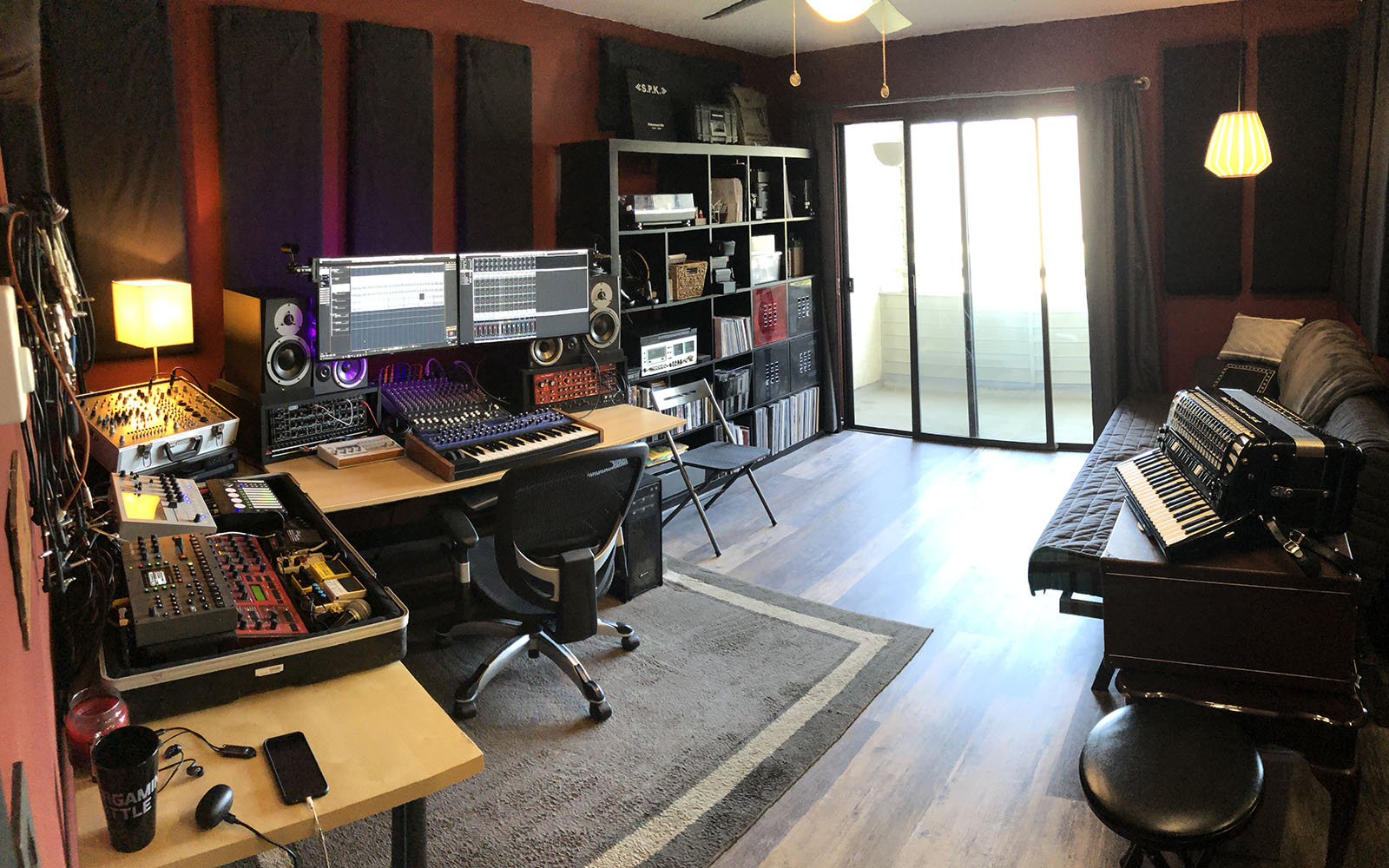A Look At My Studio

With the increasing frequency of working remotely I figured this was a good time to do a virtual studio tour of my home studio in Seattle, WA. Although one could argue a home studio isn't essential where game audio is concerned - in other words, the work can still be done without a studio - it is used for certain key elements that are very important in the development of a project. That said I have tailored my studio to streamline production of audio assets such as SFX and music but also a small-scale recording environment to handle voiceover, instrument, and foley recording.
From the photo you may notice the big black squares on the wall. These sound dampening panels are a crucial part of any studio. They do not serve to prevent sounds from leaving the room but rather to cut down on reflections within the studio so when live recordings are done you do not hear an echo or reverb in the recording. This is advantageous because it allows for more control in post production to add those elements to match the context for which they appear in the final product. These panels I have created are merely Roxul insulation wrapped in black cloth. Simple, low cost, and effective.
My reference monitor (speaker) setup is also quite important for getting an accurate interpretation of sound. My main monitor set are Dynaudio speakers with a 10” subwoofer. Having a subwoofer is very important for mixing due to the wide range of low frequency response from different consumer systems. These low frequencies can color a mix even if whatever audio system a consumer is experiencing it on can’t reproduce such low frequencies. As a backup reference system I have two older M-Audio monitors which provide some idea of how things can sound on smaller speakers. In addition I utilize a few different types of headphones as well, which are especially crucial for binaural mixes.
Synthesizers, guitar pedals, and fx boxes are of course the fun stuff! I have two Access Virus synthesizers - both desktop - the Virus B, and the Virus Snow. These are great digital synthesizers which allow me to save my favorite patches so I can return and tweak when needed. In the corner you will notice my one-of-a-kind Electro Lobotomy Noise Box which is a DIY synthesizer complete with sequencer and built-in distortion. The sound is rough and unpredictable but as for creating source material it’s extremely unique. Great for alarm sounds, robot sounds, and sci-fi sounds! Next up is my Dave Smith Instruments Mono Evolver; the keyboard that can be seen front and center. This is like splitting the difference between the Virus and the Noise Box as it contains 2 analog and 2 digital oscillators. I also use this as a MIDI controller for the various software samplers and the two Behringer synthesizers you see rackmounted on the desk. Other sound tools include my Elektron Octatrack which I mostly use for music, and the Tastychips GR-1 Granular synthesizer that can be used to create far-out pads and textures.
Which brings me to software. Being in game development means software is key. I am a Windows user and my preferred DAW is Steinberg Nuendo along with Wavelab for audio editing. I lean heavily on Native Instruments Komplete as well as a massive sfx library of both stock and custom recordings I have collected over the years. I can run any game engine that is compatible with Windows as well as any audio middleware products that need be. As an FYI my favorite combo is Wwise and Unreal!
I often do foley and field recording of which I employ several different types of microphones. A mic I have always at the ready is my Electro-Voice RE20 which is a production standard and is often used for voice recording and live production. It’s a tank of a microphone and almost anyone’s voice sounds good through it, including mine! My favorite microphone I have for foley recording in the studio is the Earthworks QTC50; it’s accurate and is great for detailed sounds. I also have two Sennheiser 421s for mid range sounds which I have used for tanks, humvees, and even accordion! My shotgun mic is a Sennheiser 416 which I mainly use for field recording quieter sounds in loud environments. I usually use my Focusrite 18i20 Scarlett as a preamp or sometimes my Mackie Onyx interface.
For efficiency I make use of a dual monitor setup (visual) as well as an audio patchbay for easy patching of in-line fx, synthesizers, microphones and various sound sources. This allows me to change direction on the fly or wire things in without having to reorganize everything. Another underrated piece of gear I use often is my SPL-SMC Surround Monitor Controller which allows me to switch my reference monitors quickly and disable all sound easily for recording.
That is a most general rundown of my sound design/composition/recording studio. I’ve spent a lifetime slowly building up to where I can complete AAA style audio in my project studio without having to depend on outside sources. It’s been a very valuable resource for both my jobs at Wargaming, and Oculus after we transitioned to a remote office for covid.
Return to main page